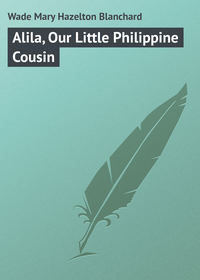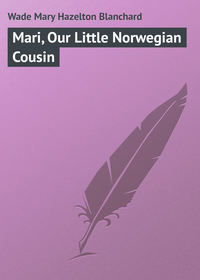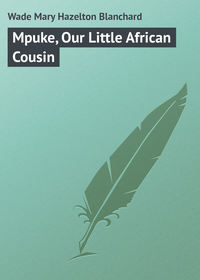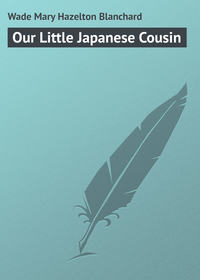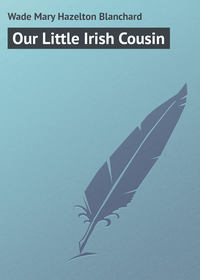 полная версия
полная версияLittle Folks of North America
Whence did these bergs come, and whither are they drifting so slowly? You look ahead and there before you is the Muir glacier entering the sea. As you draw nearer it seems like a mighty fortress. The captain of the steamer tells you that its face is three miles wide, and that all these icebergs, among which the ship has to be steered so carefully, have broken away from this one glacier. He does not dare to carry his passengers too near, for some time, without any warning, a fresh berg may break away. As it plunges into the bay, with a noise like thunder, it will stir the waters into an angry whirlpool.
There are many other glaciers in Alaska, but this one is the largest and the most wonderful of them all. Geysers and volcanos are also to be found in the country. One of the mountains, named Mt. McKinley, is the highest peak in North America. Another, Mt. Elias, rises almost out of the ocean, and its cloak of snow and ice reaches nearly to its base. When boys and girls wish to travel where they can see many strange and wonderful sights, they would do well to take a summer’s trip to Alaska, – the land of gold and fur, of waterfalls, geysers and glaciers.
CHAPTER IV
Little Folks of Canada
The First White SettlersIf you look at the map of North America, you will find that nearly the whole upper half, with the exception of Alaska, bears the name of the Dominion of Canada. Its northern shores are bathed by the cold waters of the Arctic Ocean. On the east is the great Atlantic, and on the west is the stormy Pacific. The boys and girls who live in this vast country can travel for hundreds of miles along mighty rivers; they can sail on lakes so great that they may lose sight of land and grow seasick from the motion of the boat as it moves through the waves; they can climb high mountains capped with snow in the hottest summer weather; they can wander over vast prairies for days and even weeks at a time with no view of anything as far as the eye can see, save miles and miles of grass; they can lose themselves in thick forests where only wild animals and Indian hunters have ever ventured before. All these things are possible for the Canadian child without moving out of the land which he calls home.
Once upon a time, less than fifty years after Columbus discovered the New World, a brave Frenchman named Jacques Cartier left his sunny home in France, and sailed into the west. The king of France had heard of the wonderful land which Columbus had discovered, and which the Spaniards had begun to settle. He wished to have some part of it for himself, so he directed Cartier to go farther north than the Spaniards had done. When he reached a good place for a home, he was to land and set up the flag of France.
Cartier, with two ships, each of which bore sixty-one men, set out. They crossed the ocean and arrived on the coast of a large island. Its shores were still blocked with ice, although it was the month of April. To-day we know this island as Newfoundland or New-found-land. The Frenchmen were not pleased with the country, for it looked bare and rocky. When they landed, they were met by savages with red skins and black hair tied on the top of their heads, “Like a wreath of hay,” as Carter said. He was quite sure that this was not a fit place for a home; so the ships were turned northward. They soon entered a large gulf which received the name of the Gulf of St. Lawrence.
On the shores of this gulf the white men were also met by Indians, whose homes were their upturned canoes. The savages wore little or no clothing; they lived on fish and flesh that was scarcely cooked; they seemed poor and very savage. The country, which was the mainland of Canada, looked pleasant, and Carter set up a tall cross and took possession of it in the name of France. He induced the Indian chief to allow his two sons to go back to France with him. Then he set sail for home, eager to tell his friends of the land he had visited.
The next year Cartier returned to Canada with a goodly company. They entered the gulf of St. Lawrence, as they had done before, but they sailed on until they came to the mouth of a wide river.
“It flows from afar off,” said the two Indians who had gone to France with Cartier, and who had returned with him. “No man has ever seen its beginning,” they continued.
“Perhaps,” thought Cartier, who had no idea how vast was the new land that he had discovered, “it is not a river. It is so broad and so deep, it may be an arm of the ocean, and if I follow it, I may find the short way to India, about which so many have dreamed.”
So he and his men kept on their way up the St. Lawrence River, stopping from time to time to admire the beautiful country and the wonderful sights that met them on every hand. Wild grape vines hung from the trees along the banks, and the delicious fruit was even now ripening. Water-fowls flew over their heads, and they got glimpses of wild animals such as they had never seen before. Most interesting of all were the little Indian villages scattered here and there along the shore.
From one of the settlements Cartier was passing, the people came out in their canoes to get a better sight of the white men, but they were afraid to come close to the ships, till Cartier’s two young Indian friends spoke to them and told them not to fear. Then they came on board and listened to the story of the visit the two Indian youths had made in France, and of the wonderful things that had happened to them. The Indians were now quite sure that the strangers meant only good to them, and that there was nothing to fear.
They hastened to bring presents to the visitors and show friendship in every way that they knew. Cartier did not stay long in the place, however. He sailed on till he came to a fine harbor beneath steep, high cliffs. An Indian village stood here. To-day it is the site of the city of Quebec.
“Farther on, up the river, is a still larger town of our people, and it is ruled over by a very powerful chief,” the Indians there told him.
“But the way is long and dangerous,” added their own chief. “You had better not go there.”
When he said this, he was thinking of the store of knives, bright-colored beads, and tiny looking-glasses the white men had shown him. A few of these strange and beautiful things had been given to him. He could not bear to think of that other chief also receiving some.
But Cartier was not to be frightened. He set sail once more and for thirteen days the ships kept on their way up the river. From time to time they stopped at Indian villages where the red children and their parents came dancing about them, bringing presents of fruit and fish. The savages told many stories about the country beyond; gold and precious stones were to be found there, and there were strange beings who lived without food. Still Cartier traveled on until he reached a village of at least fifty huts.
There was a three-fold wall of stakes around it, and fields where leaves of corn were waving in the autumn wind. Behind this village was a hill which Cartier called Mount Royal. To-day, in the very spot where the Indian village once stood, is the large city of Montreal, the most important one in the country. Cartier and his men stayed in Canada for several months. They built two forts on the banks of the St. Lawrence; they made gardens, and marked out a road. They were of good heart until the long, cold winter was upon them, longer and colder than they had ever known. Many grew homesick with longing for sunny France; others fell ill. At last they decided to give up the settlement and to return home.
After that French ships visited Canada from time to time. They stopped to get loads of furs which the Indians were glad to sell, but no one came to settle in the country for many years.
At last the king of France said to himself, “I cannot hold the land on the other side of the ocean, unless I send people there to settle, and it is worth while to keep it because of the furs we can get in trade from the Indian hunters.”
He sent over a colony of settlers who came sailing one bright day into the harbor of Port Royal. They landed on the beautiful shore and were soon busy building a chapel and a fort, as well as homes for themselves. A good priest came with them. He was so kind and gentle that even the savages loved him, and were quite willing to listen to the stories that he told them of a heavenly Father, and Jesus, the Savior of men.
The Explorer ChamplainAmong the settlers was the brave Champlain, who advised building a fort above the steep cliffs under which Cartier had anchored his ships years before. Workmen were soon at work on a fort, a chapel, and homes for the settlers. It was the beginning of the strong fortress and city of Quebec.
After these first settlers, came other Frenchmen and their families, and before many years, the red children and the white were playing merrily together.
“You must love each other,” the gentle French priest had told them. “Though you are of different races, yet you are the children of the one Father.”
So it was that the sons and daughters of the Frenchmen grew up with no fear of the little savages. Why, their priests often went to live in the Indian villages, that they might better show their friendship. Indians were often invited to feasts held in the white men’s homes and joined in their sports. Moreover, the children’s own relatives often chose Indian maidens for their wives, and were very happy with them. And because of this last, there came in time to be many people in Canada who were called halfbreeds, as they were partly French and partly Indian.
The Coming of the EnglishMany years passed quietly by. The French people in Canada lived peacefully with their red neighbors. They built trading stations out in the country, and here furs were brought in great numbers by the Indian hunters. Forts were also built along the banks of the St. Lawrence, and still farther into the wilderness, on the shores of the Five Great Lakes, which separate Canada from the United States.
The French explorers and priests went even farther, for they made their way from these lakes down into the United States, never stopping till they had sailed the whole length of the Mississippi River. Everywhere they went they planted the French flag and claimed the country in the name of the king across the ocean. Now, the English, who had settled on the southern side of the Great Lakes, did not like the idea of the French becoming so powerful in North America; thus it came about after a while that there were wars between the two peoples.
The Indians of Canada took the part of their French friends. Terrible battles were fought; brave soldiers were killed; cruel deeds were done to women and little children by the savage Indians. Years passed by and the troubles did not come to an end. It seemed as though there was no way of settling matters and making peace.
All this time a little boy was growing up in England. His name was James Wolfe. He was delicate and sickly, yet his bright, clear eyes showed that he had a strong will. He longed with all his heart to be a soldier. And soldier he became, though it seemed as if he would never be able to bear such a hard life.
When he was only sixteen he fought for his country in Flanders. He soon showed how brave he was, and became a high officer in the army. He was sent to America to fight against the French and Indians. If he could only get to Quebec, he thought. It was the strongest fortress of all the enemy held. But that seemed impossible, for no one dreamed that an army could scale the steep crags above which the fortress was built.
Yet Wolfe kept thinking, thinking. By this time he was the commander of a whole fleet of English ships. At last there came a day when he sailed boldly up the St. Lawrence, and landed his men on the shore opposite to Quebec. He set up great cannons which should fire upon the fortress across the river. The siege began. In the midst of it heavy rain fell; Wolfe and many of his men became ill. Though he was burning with fever he still kept planning. One day, as he looked through his telescope, he saw something that he had never noticed before. It was a narrow path, – O, so very narrow – that wound in and out, yet ever upward, to the top of the crags that guarded Quebec.
He said to himself, “My men and I shall climb that path and take the fortress by surprise.”
Soon afterwards, on a dark night, they did climb it. Wolfe himself rose from his sick bed and led them. As the sun rose the next morning the English army appeared on the Plains of Abraham, behind the fort, and one of the great battles of the world was fought. Before night fell, Quebec was in the hands of the English. Both Wolfe, and Montcalm, the French commander were killed. Henceforth, not only Quebec, but all Canada would be ruled over by the English.
Henry Hudson and the Great Lone LandIt was in the year 1610, that a brave seaman named Henry Hudson, sailed northward along the shores of North America. He had already discovered the Hudson River in the United States, and traded with the Indians there for furs. He had tried to find a short way to India but had failed. Now he hoped by going still farther he might yet discover it. On and still on he sailed till he entered a large bay on the northern shore of Canada, which ever since has been called Hudson Bay. Here, in the midst of ice and snow, he and his men were obliged to pass the winter. There was little to eat, and it was bitter cold.
His men blamed him for bringing them to such suffering, and at last rose against him. They set him adrift in a small boat, with his young son and a few faithful followers. Then, leaving him to die of cold and hunger, they sailed for home, to tell of the large bay that had been discovered, and of the wild country around it. As time went by other Englishmen visited Hudson Bay, but they had no wish to stay long in its icy waters or on its lonely shores.
At last, however, a number of English merchants formed themselves into the Hudson Bay company.
They said, “We will send men to North America who shall build forts along the shore of Hudson Bay. They shall buy furs of the Indians, and send them to us here in England. The furs of the wild animals there are rich and beautiful, and will bring us riches.”
In this way it came about that English ships brought to Canada men who at once set to work building forts and trading stations in the neighborhood of the bay discovered by Henry Hudson. They had with them knives and hatchets, beads and bright colored blankets, – everything that an Indian might wish in exchange for his furs. They treated the red men kindly, for they wanted to trade peaceably with them, but at the same time they kept their guns ready in case of an attack by the savages.
Alexander Mackenzie and his long JourneyEven after the English had won the country for themselves, they did not know how large it was, for no one had explored the country from north to south or from east to west. At last a brave Scotchman named Alexander Mackenzie came to settle in Canada. He was fond of adventure and liked nothing better than roaming for miles through the wilderness, hunting the wild animals in the forest, and skimming over the lakes and down the streams in an Indian canoe. He visited many a settlement where the red children had never before looked upon a white man; he discovered rivers and lakes of which the French and English knew nothing before. He arrived in his wanderings on the shore of the Great Slave Lake in the very heart of the country. A large river flowed out of it. Where did it go, and how far? The Indians could not tell him.
At the beginning of the summer, he set out with a small party of white men and an Indian guide. At first it was very pleasant paddling down the river in their canoes, but after a few days they came to rapids. Then they had to take to the land and carry their canoes and their supplies on their shoulders. As they traveled onward they came to still other rapids which stopped their course again and again.
The farther north they traveled, the colder it became. The days were much longer, too, for it was nearing mid-summer. It seemed very strange to them to have the midnight as bright as daylight. The wild animals were scarce now.
“Suppose,” thought Mackenzie, “we are unable to shoot enough for our food,” but still he kept on. He passed Indian villages on his way, and at last met with Eskimos who were wandering about on their summer hunt.
The wild animals were different now from what the explorers had met before; they had reached the home of the polar bear and the arctic fox. The river was full of broken ice and there were whales in the water. They were close to the shores of the Arctic Ocean, and had traveled a thousand miles down the great river, which they named Mackenzie in honor of their brave leader. The party did not remain long in the bleak, northern country, but turned about and journeyed homeward as quickly as possible.
Three years afterwards Mackenzie made up his mind to cross Canada to the westward. Slowly but surely he made his way, now gliding along a stream or over a lake in his canoe; now cutting a path through a thick forest; again finding himself stopped by high cliffs or by a rushing torrent. But he kept on until he came to the Rocky Mountains, whose snowy tops reached far up towards the heavens.
“Not far beyond those mountains is the sea,” Mackenzie’s Indian guide told him.
He still pushed on, through narrow passes, between walls of rock, up steep slopes and down through deep valleys. At last he reached the other side, launching his boats in a stream flowing to the west. In a short time the Pacific Ocean lay stretched before his eyes.
Among the Eskimos and IndiansThe middle of Canada is a great plain, which ends in the north in frozen marshes, where the homes of the little Eskimos are to be found. There, in the midst of the ice and snow they work and play, in much the same way as their brothers and sisters in Greenland and Alaska.
Farther south, yet still where the summer is short, and the winter is long and cold, Indian children camp out on the prairies and on the borders of the forests. Most of these red children live in tents, or tepees, as they call them. The winter tents are lined with heavy skins, and a large fire burns in the middle, around which they sleep during the cold winter nights. They dress in the skins of the wild animals their fathers have killed, and they wear soft moccasins on their feet. They run many a mile in these moccasins without getting tired or losing their breath.
Sometimes the little Indians have great feasts when ducks and geese, deer and hares are to be found, or when the berries and birds’ eggs are plentiful. But many a time during the long winter game is scarce, and there is no food to be had. Then the children must not complain, though they are faint with hunger. If an Indian child hopes to grow up and be a brave man, he must learn to bear many things and show no one how much he is suffering.
Fearful storms rage about his home in the winter. The snow falls hour after hour and the fierce winds drive it in great gusts. Sometimes in summer the winds blow hard too, but then they are hot and dry and they scorch the faces of those who are exposed to them.
The red children learn many things not to be found in books. They look at the grass, – the way the blades turn shows them where to look for the east and west. The flight of birds warns them of a coming storm and in what direction to look for it. A broken twig tells them that a wild animal has passed by.
They have many sports. In winter they bind snow-shoes on their feet and skim over the snowfields. In summer they ride over the prairies on their ponies with pads of deer skin beneath them.
Sometimes they let their ponies move along at a slow walk; but more often they gallop wildly along, with black hair waving in the air, and with bright and eager eyes. Then, too, the red children have canoes, in which they paddle on the lakes or streams near home.
The canoe of the Canadian Indian is the best possible boat for the kind of life he follows, just as the Eskimo’s kayak suits the icy waters of the north. Everything he needs for it can be found in the forest. He cuts down the cedar for its ribs, he gathers birch-bark with which to cover it, he gets resin from the pine to make it water-tight. When the ice begins to break up in the springtime and the wild swans and geese fly overhead, then he takes it from its winter resting place beneath the snow and launches it on the lake or stream near his home. With his birch canoe he can travel a long way through the wilderness, for when he has hunted or fished all day long, he can bring his canoe up on the shore and turn it bottom upwards. In an instant he has a roof to shelter him while he takes his night’s sleep.
The Indian children are sure to have dogs about their home. These are long-legged, sharp-nosed creatures, and they always look lean and hungry. Sometimes a puppy is cared for tenderly. Then, perhaps, it grows up full of love for its young master. But generally the dogs are only half-fed, and they are ever ready to fight with each other, and rob the stores of their masters. Yet they are very helpful to the Indian, as well as to many a white traveler in Canada. They drag the sledges over the snow in the winter and the little carts in the summer.
Many a time they stop to quarrel among themselves; many a time the sledge is over-turned and the rider is landed in a bank of snow. Many a time the dogs refuse to obey the word of the driver. Then the long whip flies right and left among them, and with angry howls they get back into order.
Wild Animals of the Forest and PrairieOut on the prairies and among the forests are many wild animals which the Indian boy delights to hunt. He has a bow and arrows of his own, and when he his older, his father promises him that he will buy him a gun from the white traders. Perhaps the most clever of all the animals hunted in Canada is the beaver. It might well be called the animal-carpenter. Its favorite home is a shallow lake or stream. The children of the wilderness are ever on the lookout for small earth mounds along the banks. Whenever they find these, they also notice that trees have been cut down nearby. It was certainly the work of beavers. These little mounds, then, are the roofs of store houses where the wise little creatures have placed piles of tender wood and roots, for their winter’s supply.
From these store-houses, tunnels have been dug out for some distance under the shallow water of the pond or stream, to the very doors of the beavers’ homes, which have been made very carefully out of twigs and brush, and plastered with mud. The tops can generally be seen above the surface of the water. Inside there are beds of boughs covered with soft grass and bark, and here the beavers sleep most of the hours during the winter. If the hunters come upon a beaver village in cold weather, there is no sign that the animals are near, for the beavers are all inside their homes. This is the time to get them, however, for then the soft thick fur is at its best.
In the autumn the men and boys generally catch the animals in traps, but in the winter, when the ice is frozen quite solid, the hunters stop up the passage from the beaver’s home to his store-house on the bank. Then with their axes, they break into the lodges, and dragging out the fat sleepy animals, they kill them, one by one. The sledges are soon packed and the hunters start for home, thinking as they go, of the feast of fat meat they will soon have. The beautiful furs must be tanned and put away for the traders, but the flesh of the animals they will enjoy themselves.
Besides beavers, there are martens, minks and fishers to be hunted and trapped, as well as muskrats and skunks. As soon as autumn comes the men and boys begin to put their traps in order, for with the first cold of November, they will carry them out to the pine forests. The Indian children would tell you that they cannot imagine why the fisher is so called. They know its ways and that it never goes near to the water except when it has to cross over to the other side. It has a long bushy tail and its fur is even richer than the costly sable.
As for the mink, they have discovered it is quite different from either the marten or the fisher, and its fur is not as beautiful. It lives near the streams and feeds upon crabs and fish. Many a time the young Indian has caught a mink by baiting his trap with fish.


